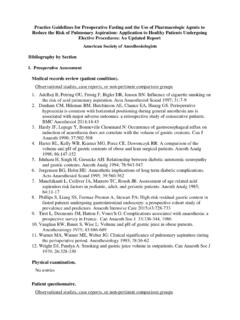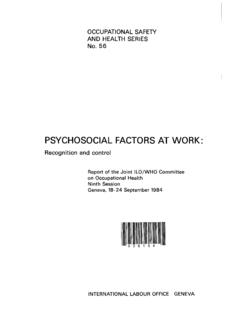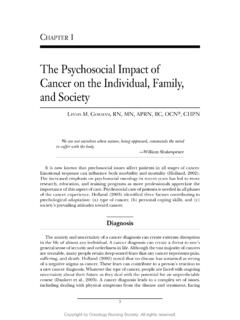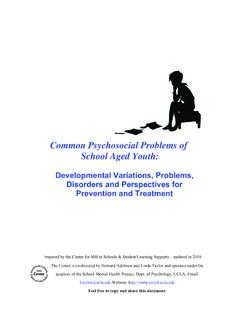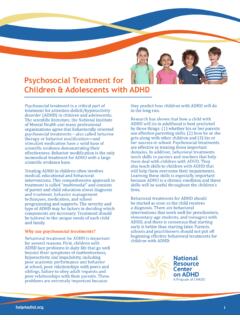Transcription of Stanford Integrated Psychosocial Assessment for Transplant ...
1 Stanford Integrated Psychosocial Assessment for Transplant (SIPAT). Stanford University Medical Center Maldonado et al, 2008; Maldonado et al, Psychosomatics 2012 Page 1 of 11. Patient's Name: _____ Date: _____. Patient's MR#: _____ Total Score: _____. SIPAT Examiner: _____. A. PATIENT'S READINESS LEVEL. I. Knowledge & Understanding of Medical Illness Process (that caused specific organ failure). 0) Excellent Understanding: Patient & support system are fully aware of the cause(s) of illness leading to organ failure and need for transplantation. Both patient and support system demonstrate a high degree of self-directed learning. 1) Good Understanding: Patient & support system are mostly aware of the cause(s) of the illness process and contribution to current health status. 2) Moderate Understanding: Patient has modest knowledge despite teaching/material provided.
2 Or A patient who just found out about his/her condition and has not received Transplant -related education. 3) Limited Understanding: Patient has only rudimentary knowledge despite of years of illness and/or extensive teaching by providers. 4) Poor Understanding: Extreme denial or indifference is evident. II. Knowledge & Understanding of the Process of Transplantation 0) Excellent Understanding: High degree of self-directed learning and excellent knowledge of treatment risks & benefits. 1) Good Understanding: Patient & support have studied & understood provided literature. 2) Moderate Understanding: Patient has modest knowledge despite teaching/material provided . Or A patient who just found out about his/her condition and has not received Transplant -related education. 3) Limited Understanding: Patient only has only rudimentary knowledge despite of intensive teaching by providers.
3 4) Poor Understanding: Extreme denial or indifference evident. III. Willingness/Desire for Treatment ( Transplant ). 0) Excellent: Patient is highly motivated and proactively involved in his/her medical care. 1) Good: Patient expresses interest and is actively involved in his/her care 2) Moderate: Patient appears ambivalent; only passively involved in process; actions are only acceptable at best. Or A patient who just found out about his/her condition and has not received Transplant -related education. 3) Limited: Patient who has limited involvement in his/her care. Family member or medical team appears more interested in the Transplant process than patient. 4) Poor: Family member or MD pushing patient to participate in the transplantation evaluation process; the patient is uninterested or mostly unengaged. Stanford Integrated Psychosocial Assessment for Transplant (SIPAT).
4 Stanford University Medical Center Maldonado et al, 2008; Maldonado et al, Psychosomatics 2012 Page 2 of 11. IV. Treatment Compliance/Adherence (Pertinent to medical issues). 0) Excellent: Patient is fully compliant and is an effective partner with medical staff. 2) Good: Patient is mostly compliant; requires redirection or reeducation; but no significant negative outcomes are documented. 4) Moderate: Only partially compliant or excessive self-management; requires multiple efforts and persuasion from the Transplant team and/or family Or A patient who just found out about his/her condition and has not received Transplant -related education. 6) Limited: Only compliant after the development of complications or side effects. 8) Poor: Evidence of significant treatment non-adherence with negative impact to patient's health ( , treatment non-adherence/compliance; continued substance use after learning of illness).
5 V. Lifestyle Factors (Including diet, exercise, fluid restrictions; and habits according to organ). 0) Able to modify & sustain needed changes- self initiated. 1) Patient is responsive to recommended changes. 2) Patient is reluctant, but compliant with recommended changes, after much prompting and encouragement from support & Transplant team. 3) Patient complies with recommended changes only after the development of complications. 4) Unhealthy diet & sedentary lifestyle. Reluctant to change despite efforts from treatment team and support system ( , non-adherence with recommended restrictions; continued substance use after learning of illness). B. SOCIAL SUPPORT SYSTEM. VI. Availability of Social Support System 0) Excellent: Multiple family, significant others &/or friends have been identified and ARE. actively engaged as part of the support system. Excellent back-up system in place.
6 2) Good: Various individuals ( , minimum of two people) have been identified and are actively engaged in the patient's care. A back-up system, albeit limited, seems feasible. 4) Moderate: A back-up system has not been confirmed or appears limited / tentative. 6) Limited: The patient's identified support system appears tentative, inconsistent, unreliable, conflicted, uncertain or uncommitted. Identified backup system's reliability is 8) Poor: Patient unable to identify reliable support system, or identified caregiver has failed to present to clinic. No reasonable back-up support system is in place. Stanford Integrated Psychosocial Assessment for Transplant (SIPAT). Stanford University Medical Center Maldonado et al, 2008; Maldonado et al, Psychosomatics 2012 Page 3 of 11. VII. Functionality of Social Support System 0) Excellent: Members of the support team have demonstrated initiative in learning and are already committed to and actively and effectively engaged in the patient's care.
7 2) Good: A limited support system has already committed to and has had effective engagement in the patient's care. Or, they are not involved yet, but appear ready to help. 4) Moderate: Members of the patient's identified support system may themselves need some Psychosocial work before they are ready for transplantation. 6) Limited: Member of the identified support system themselves have problems ( , medical or Psychosocial ) which may impair or limit their ability to reliably assist the patient OR The identified person(s) have expressed doubts/hesitation/conflict. 8) Poor: Patient has suffered due to unreliable support system OR the Transplant team has not been able to effectively work with the support team. VIII. Appropriateness of physical living space & environment 0) Excellent: Patient has excellent, long-term, permanent and adequate housing. 1) Good: Patient has some stable housing arrangement, albeit not optimal.
8 2) Adequate: Reported arrangement is only temporary and/or tenuous. 3) Limited: Unable to confirm reported arrangement or perceived to be inappropriate. 4) Poor: Non-existent; patient has no stable living arrangements OR lives in environment that doesn't promote Transplant health. C. PSYCHOLOGICAL STABILITY & PSYCHOPATHOLOGY. IX. Presence of Psychopathology (mood, anxiety, psychosis & others). (Other than organic psychopathology [ ] & personality disorders [ ]) (Use clinical judgment. If the patient demonstrates clinical signs of psychopathology please follow up with appropriate diagnostic exam ( , depression ( ] or anxiety [QIXb]). 0) None: No history of psychiatric problems. 2) Mild Psychopathology Present or History of mild psychopathology ( , Adjustment disorder). Usually a self-limited problem without significant negative impact on level of functioning.
9 No hospitalization needed. No History of SI/SA. 4) Moderate Psychopathology Present or history of moderate psychopathology ( , depressive or anxiety disorder). Treatment, if needed, has been/was effective, good compliance. No SI/SA at present; although possible history SI/SA in past. 6) Severe psychopathology. Present or history of severe psychopathology ( , severe mood, anxiety or psychotic disorder with significant impairment of Psychosocial functioning). Patient has needed psychiatric hospitalization(s) in the past or + . history of SI/SA. 8) Extreme psychopathology. Present or history of severe psychopathology ( , as above) usually associated with repeated episodes of psychosis or suicidality; and associated with a history of multiple psychiatric hospitalizations and/or treatment with ECT; or history of multiple SI/SA). Patient may be in need of acute psychiatric intervention before proceeding.
10 Stanford Integrated Psychosocial Assessment for Transplant (SIPAT). Stanford University Medical Center Maldonado et al, 2008; Maldonado et al, Psychosomatics 2012 Page 4 of 11. IXa. Assessment of Depression (Use clinical judgment; Patient Health Questionnaire [PHQ] or Beck Depression Inventory [BDI], if available). 0) No Clinical Depression; or PHQ < 5; or BDI= 0 13. 1) Mild Clinical Depression; or PHQ = 5 9; or BDI= 14 19. 2) Moderate Clinical Depression; or PHQ = 10 19; or BDI= 20 28. 3) Severe Clinical Depression (includes psychosis and/or suicidality); or PHQ 20; or BDI = 29 63. IXb. Assessment of Anxiety (Use clinical judgment; Generalized Anxiety Disorder questionnaire [GAD-7] or Beck Anxiety Inventory [BAI], if available). 0) No Clinical Anxiety; or GAD-7 < 5; or BAI = 0 7. 1) Mild Clinical Anxiety; or GAD-7 = 5 9; or BAI = 8 15. 2) Moderate Clinical Anxiety; or GAD-7 = 10 14; or BAI = 16 25.





